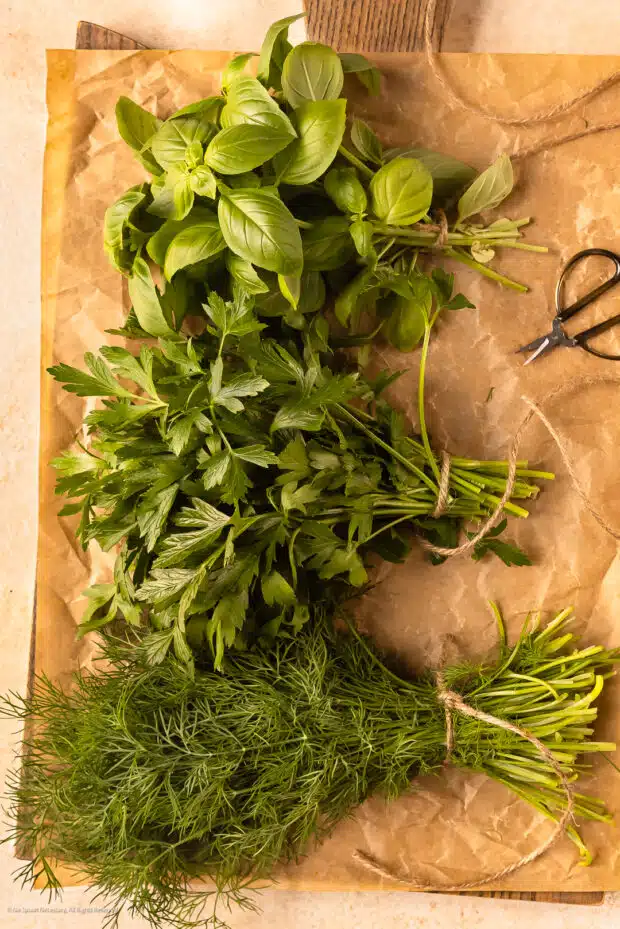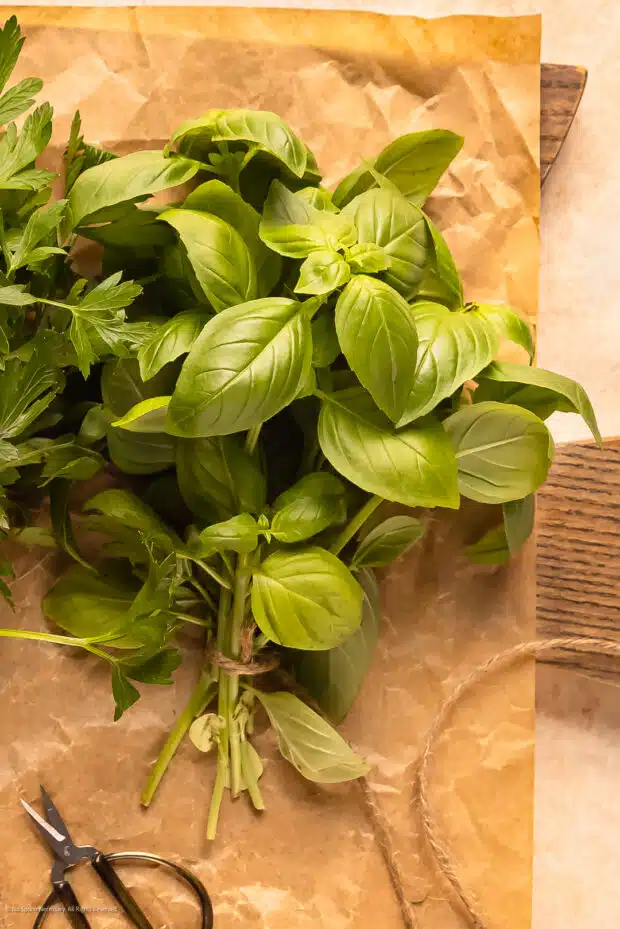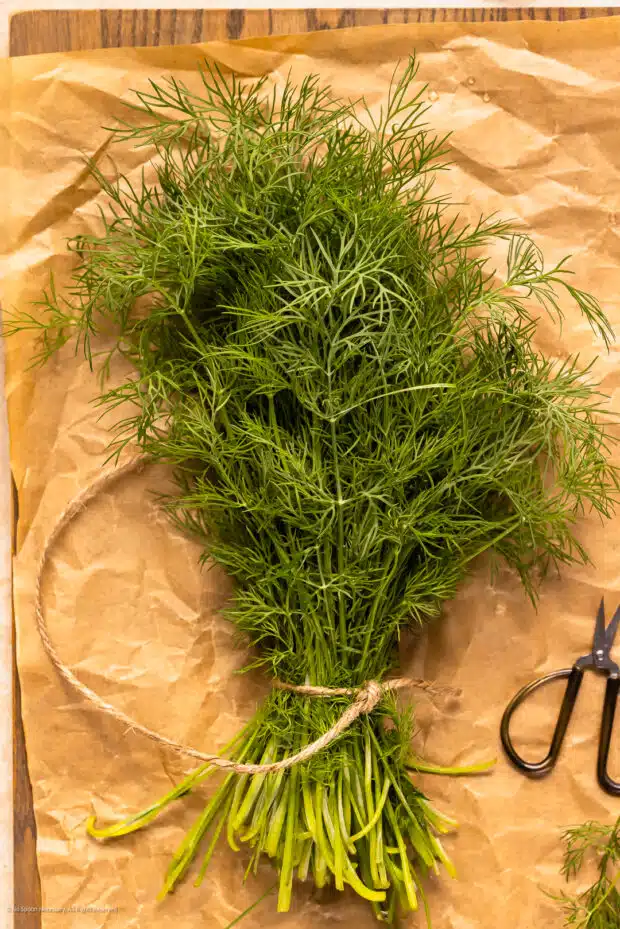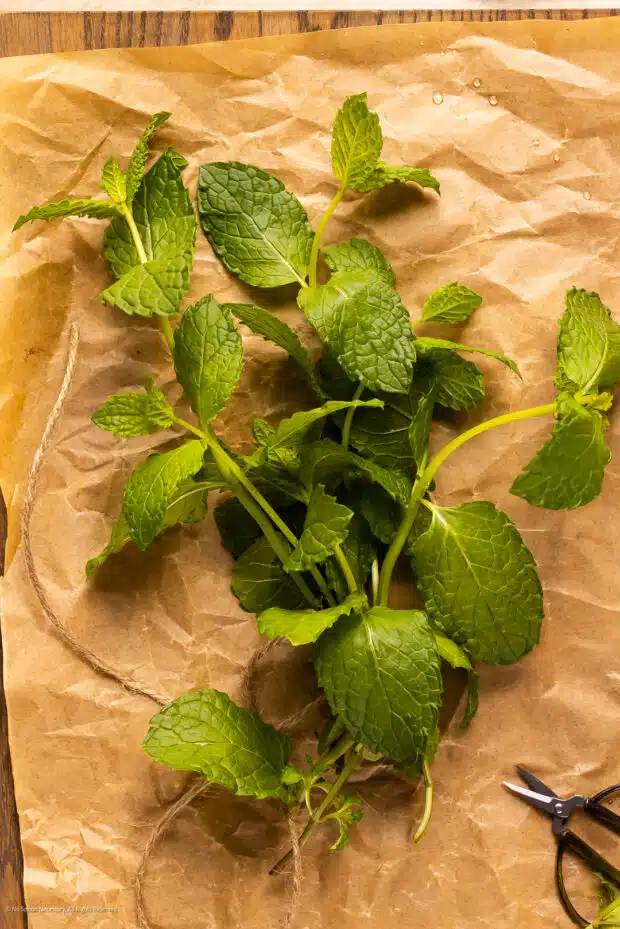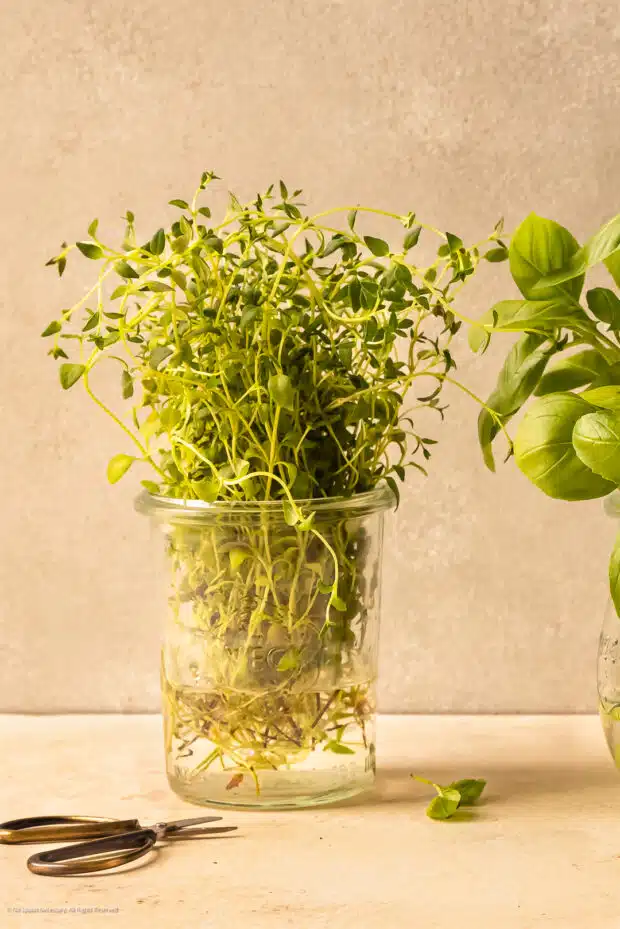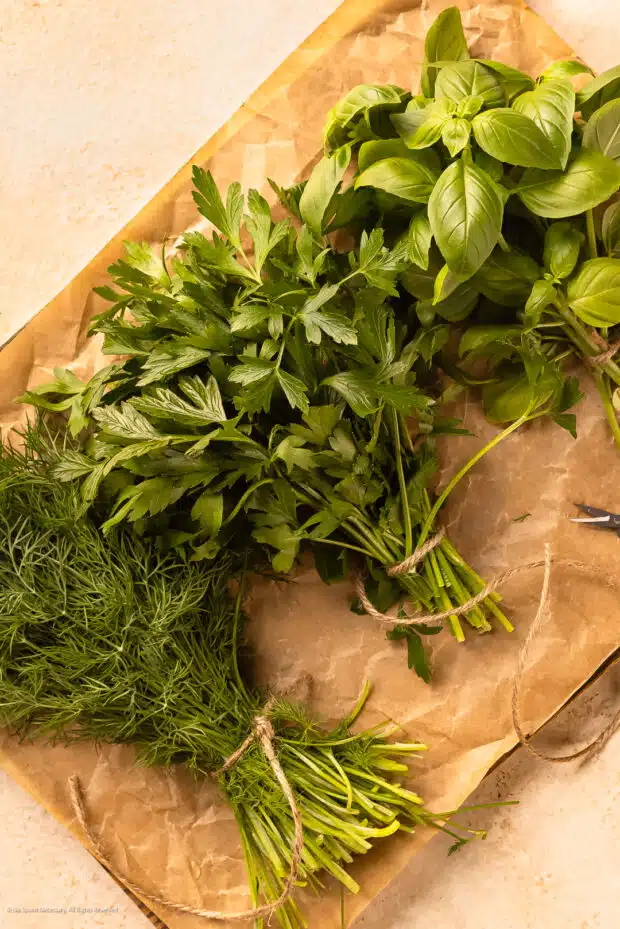This post may include affiliate links. Thank you for your support.
Do you confuse flat-leaf parsley with cilantro at the grocery store? Or wonder what tarragon tastes like? Stop wondering how to cook with fresh herbs and get all your burning questions answered! This informative herbs guide covers 14 different types of fresh green herbs and how to use them in the kitchen.
Table of Contents
What are fresh herbs?
In the simplest terms, fresh herbs are leafy, aromatic, flavorful plants that are added to dishes in small amounts to add more flavor or as a garnish. Essentially, you can think of a fresh herb as a fresh seasoning. This makes herbs distinctly different from vegetables, which are used to add sustenance and substance.
While fresh herbs are usually green; however, there are roughly 100 different herbs in the world and some color variations, such as purple basil, do exist.
Types of herb
There are two main categories or types of fresh herbs: soft, leafy herbs (you can eat the stems) and woody, hardy herbs (you must pick the leaves from the stems as the stem isn’t edible). Below are the most common types of herbs that fall into each category:
List of soft herbs
- Basil
- Cilantro
- Dill
- Parsley
- Tarragon
- Mint
Types of woody herbs
- Chives
- Oregano
- Rosemary
- Sage
- Thyme
14 common fresh herbs
Below is a list of the fourteen most common types of herbs used in the kitchen.
Basil
Highly aromatic soft basil leaves provide a sweet and robust licorice flavor foods. Basil is particularly popular in Italian, Mediterranean, and Thai cuisines. And you can find it used in classic dishes, such as tomato basil soup and Thai basil beef.
However, you’ll want to avoid cooking basil leaves. Instead use them raw just before serving to add a note of freshness to dishes.
Fresh basil pairs well with bell peppers, cheeses, chicken, chocolate, eggplant, egg dishes, fish, lamb, meats, mint, mussels, olive oil, olives, oregano, pasta and pasta sauces, peaches, pesto, pineapple, pizza, pork, potatoes, poultry, rabbit, rice, salads and salad dressings, salmon, sauces, shellfish, soups, tomatoes, veal, vegetables, watermelon, and zucchini. Avoid pairing basil with tarragon.
Chervil
Chervil is a member of the parsley family. This soft herb lends a delicate, aniseed flavor to the ingredients it’s paired with. Fresh chervil is popular in Provençal cuisine and typically makes an appearance raw in salads or as a finishing garnish.
This quiet, delicate soft herb pairs well with asparagus, carrots, eggs and egg dishes, fish, game birds, lettuce, lobster, peas, potatoes, poultry, salads, shellfish, soups, tomatoes, veal, venison, and vinegar.
Chives
The chive is a relative of the garlic, leek, onion, and shallot family. Chives lend a subtle onion flavor to foods and are a common ingredient in Chinese cuisine and stir-fries.
Fresh chive pairs fantastically with avocados, cheese, chicken, cream sauces, egg dishes, fish, onions, pasta, pork, potatoes, salads, shellfish, smoked salmon, and vegetables, especially root veggies and zucchini.
Cilantro
Also known as coriander, cilantro is a polarizing herb. While some people believe this soft herb tastes like soap, cilantro is an essential ingredient to regional cuisines, like Asian, Caribbean, Indian, Latin American, Mexican, and Thai foods. Love it or hate it, cilantro has its place in dishes like pico de gallo, fajitas, fish taco bowls, and chicken curry salad.
Try this bold, soft-leaved herb with avocados, chicken, chile peppers, coconut, cumin, fish, garlic, ginger, lemongrass, lentils, pork, poultry, potatoes, rice, salads, salsas, shellfish, soups, stews, tomatoes, vinaigrettes, and yogurt.
Some say you should avoid using fresh cilantro in Japanese cuisine; however, fusion cuisines are perfectly fine.
Dill
Moderately flavorful dill brings sour, sweet flavors to the party. The feathery fronds of dill are commonly used in European, Mediterranean, and Middle Eastern cuisine.
French rillettes is a common dish made with dill. However, fresh dill fronds pair wonderfully with asparagus, avocado, beans, beets, cabbage, carrots, chicken, corn, cream sauces, cucumbers, egg dishes, fish, lamb, mushrooms, pickles, potatoes, poultry, salads, salmon, scallops, and shellfish.
Garlic
While garlic is shaped like a bulb, it is in fact an herb or fresh seasoning.
Marjoram
Marjoram is a botanical relative of oregano; however, it’s important to note that it is a quiet, mellow relative of oregano. With a moderate sweet, spicy flavor, Marjoram is used at the end of the cooking process in French, Italian, Mediterranean, North African, and North American cuisines. And you can find marjoram as an ingredient in bouquet garni and fines herbes.
Fresh marjoram pairs well with delicate-flavored foods, such as artichokes, asparagus, carrots, chicken, duck, eggs, fish, green beans, potatoes, tuna, shellfish, and summer vegetables. However, it also works with heavier dishes and more flavorful ingredients like, grilled meats, lamb, mushrooms, pasta (especially ravioli), pork, rabbit, risotto, and veal.
Mint
Quiet, cooling mint lends a moderate sweetness and clean freshness to dishes that tastes a bit like “false coolness”. Fresh mint is a notable addition to Mediterranean, middle eastern, and Moroccan cuisines – with tabbouleh (summer rice salad) being a standout dish, as well as Thai and Vietnamese dishes – with spring rolls being amongst the most popular.
However, this fresh seasoning complements a wide range of ingredients: beans, beef, berries, carrots, cheeses, cucumbers, desserts, eggplant, fish, fruits, lamb, lentils, lettuce, melons, mushrooms, pasta, potatoes, poultry, pumpkin, salads, salsas, tomatoes, vegetables, and yogurt all taste great with a hint of mint.
And don’t forget about beverages and desserts! Mint is best friends with drinks and cocktails, especially those made with apples, blackberries, bourbon, champagne, citrus, milk, fruit punch, strawberries, tropical fruits, and watermelon. As for desserts, pair it with chocolate, especially dark chocolate, and ice creams.
Oregano
Fresh oregano can vary greatly in flavor from mild Italian oregano to spicy Greek oregano. However, it typically lends a robust, slightly lemony flavor.
You’ll want to avoid using this fresh seasoning with desserts and sweet treats as it has a firmly savory flavor that shines with Italian, Greek, Mediterranean, Mexican, and Tex-Mex cuisines.
Oregano plays well with anchovies, artichokes, arugula, basil, beans, beef, bell peppers, cheese and cheese dishes, chicken, chile peppers, eggs, eggplant, fish, hamburgers, lamb, lemon, meats (especially red meats), mushrooms, olives, pasta and pasta sauces, pizza, pork, potatoes, poultry, rabbit, salads, sausages, seafood and shellfish, soup, stuffing, tomatoes, veal, and vegetables.
I love using fresh oregano in Bolognese and chimichurri for grilled steak.
Oregano vs Mexican Oregano
There are different subspecies of oreganos depending upon the region where its grown – Greek, Mexican, Turkey, and Italian Oregano. And each subspecies varies slightly in flavor. Greek oregano, also known simply as “oregano” and Mexican are the most widely used oreganos, so we will discuss them here.
Greek oregano, or Mediterranean oregano, is earthy, grassy, pungent, minty, and slightly bitter, with a hint of subtle sweetness.
While Mexican oregano is more earthy, grassy, and pungent. It’s also peppery and citrusy with a little spice to it.
Parsley
Arguably the most popular fresh herb, parsley is so much more than just an old-school garnish. This light and subtle herb is compatible with virtually all other fresh herbs. While there are two types of parsley – flat-leaf parsley and curly parsley – the term “parsley” typically refers to the flat-leaf variety. This readily available herb plays well with most things, however, it especially tastes delicious with beans, beef, braised dishes, bulgur wheat, carrots, cheeses, chicken, clams, cream, eggs, eggplant, fish (especially halibut), game, ham, meats, olive oil, pastas and pasta sauces, peas, pork, potatoes, poultry, rise, salads, sauces, sausages, seafood (especially shrimp, skate, and snails), soups and stews, homemade stocks, stuffing, tomatoes, veal, and vegetables.
Just like oregano, you’ll want to avoid adding fresh parsley leaves to sweet dishes and desserts.
Curly vs flat leaf parsley
Flat-leaf and curly are two varieties of parsley; however, they couldn’t be more different in both appearance and flavor.
Curly parsley is grassy, bitter, and salty in taste with ruffly, thick leaves.
On the other hand, flat leaf parsley, also called Italian parsley, is bold, fragrant, and aromatic in flavor with broad, flat leaves.
It’s important to note that when a recipe calls for “parsley” it’s typically referring to flat-leaf parsley. Curly parsley is generally reserved as a garnish for lower-end dishes.
Rosemary
Hardy rosemary lends a pungent, strong flavor and piney aroma to the foods it’s paired with. This loud, tough-leaved herb is a perfect match for assertive meats and poultry; however, it also works well with full-flavored seafood dishes, like pan-fried mussels. Fresh rosemary is a common ingredient in French, Italian, and Mediterranean cuisines.
When using rosemary, it’s important to remember that a little can go a very long way. Also keep in mind that fresh rosemary has a stronger flavor in the summer months and a milder flavor in the winter.
Try this fresh seasoning it with anchovies, bacon, beans, beef, bell peppers, cabbage, chicken, duck, eggs and egg dishes, fish, game (especially rabbit and venison), grains, grilled foods, lamb, lavender, lentils, marinades, milk, mushrooms, olive oil, onions, peas, pizza, polenta, pork, potatoes, rice, risotto, sauces, and scallops.
Rosemary also tastes yummy in baked goods, like breads, cakes, cookies, and fruit desserts. Plus, it pairs perfectly with lemon beverages and gin cocktails.
Sage
Bold sage has a sweet, bitter, sour, pine-like flavor with notes of eucalyptus and lemon. This herb is more pleasant when cooked (versus raw). Therefore, you should always add sage to the dish near the end of the cooking process, giving it a chance to cook. Never use raw sage to garnish a dish.
If you’d like to use sage leaves as a garnish, fry the leaves in butter, bacon fat, or olive oil for a beautiful, crispy, and flavorful finishing touch. Or try adding fresh sage when cooking asparagus, beans, beef, cabbage, carrots, cheese (especially brie, feta, gruyere, parmesan and ricotta), chicken, chickpeas, corn, cream, duck, eggplant, eggs, meats, game, goose, honey, lamb, liver, mushrooms, offal, olive oil, onions, oysters, pancetta, pasta (especially stuffed pastas like gnocchi and ravioli), peas, pork, potatoes, poultry, prosciutto, pumpkin, rice, sausages, shellfish, soup and stew, stuffing, tuna, turkey, veal, and winter squash.
Moderately heavy fresh sage also plays nicely with sweeter applications, like a dessert or snacks with blueberries or cherries, and homemade breads.
Tarragon
One of the lesser popular herbs, tarragon has a loud, licorice flavor and light aroma. Unlike other fresh herbs, tarragon really works best on its own (as opposed to pairing it with other fresh herbs). It should be used in moderation and tastes best with acidic foods, chicken, cream sauces, egg salads, fish, potatoes, red meats, shellfish, tomatoes, and vinegar. However, it also works with beets, carrots, cheese, crab and crab cakes, game, greens, lentils, lettuces, lobster, melon, mushrooms, mussels, oysters, pasta, peaches, pork, rabbit, rice, shrimp, spinach, veal, and red wine.
Avoid using tarragon with desserts and sweet dishes, as well as the fresh herbs oregano, rosemary, and sage.
If you’re wondering whether you’ve tried tarragon before, it’s a star ingredient in the classic French sauce, béarnaise.
Thyme
Delicate thyme leaves lend a woody smell and flavor to dishes. This popular fresh herb is moderately strong in flavor, but not overwhelmingly so. It’s a common herb in American, French, Greek, Italian, Jamaican, and Middle Eastern cuisines, and it pairs lovely with heavier soups and stews, like corn chowder or gnocchi soup.
However, thyme leaves pair well with a wide variety of ingredients, like apples, bacon, beans, beef, beer, braised dishes, casseroles, cheese, chicken, corn, curries, eggplant, eggs, fish (especially cod), game, lamb, legumes, marinades, meats and meatloaves, mole sauces, mushrooms, onions, parsnips, pastas and pasta sauces, pork, potatoes, poultry, rabbit, rice, roasts, sauces (especially tomato sauces and red wine sauces), seafood, stuffing, tomatoes, and vegetables.
Fresh thyme also tastes great in breads and baked goods, like focaccia.
FAQs: fresh herb
Why use herbs in cooking?
The fresh herb is a magical ingredient for many reasons; however Chef’s mostly praise herbs for their power to enhance the flavor of a dish. But different types of herbs are also brimming with health benefits and nutrients, such as antioxidants, anti-inflammatories, and essential vitamins.
Annual vs perennial herbs
Annual herbs and plants live for only one growing season; then they die and need to be replanted. However, it’s important to note that while annuals have a short life span, they usually grow quickly and have a longer blooming period than perennials. Annuals have tender, green stems, and fall into the “tender herb” category. Some common varieties include basil, cilantro, dill, Italian parsley, and French tarragon.
Perennial plants and herbs regrow every spring and continue to live for many years, requiring no replanting. However, please take note that perennials grow slowly and do best in moderate climates, or colder places. Perennial herbs are your woody herbs. Some common varieties include rosemary, thyme, and bay leaf.
Fresh vs. dried herbs
In a perfect world, you’d have an endless supply of fresh herbs at your disposal for making all your favorite recipes. Unfortunately, we live in the real world and most of us don’t have a sprawling herb garden out back.
Therefore, most of you may be wondering: Can I just use dried herbs instead of fresh? And exactly how much dry herb can I use without ruining family dinner?
First of all, you can absolutely use dry herbs instead of fresh, and vice versa. But, it’s important to keep in mind that a dried herb is stronger and more concentrated in flavor than a fresh herb, so you’ll need to use less. A general kitchen rule of thumb: use one-third as much of a dry herb as you would a fresh herb. For example, if a recipe calls for a tablespoon of fresh dill, you’ll need just 1 teaspoon of dried dill since there’s 3 teaspoons in 1 tablespoon.
However, there are a few specific cases where you can’t substitute a fresh herb with the dried counterpart because the flavors are not an exact match. Cilantro and tarragon are two examples of this – as fresh tarragon and fresh cilantro taste completely different from dry tarragon and ground coriander.
Another thing to keep in mind: dry herbs stand up to heat much better than fresh. Therefore, it’s typically best to add dry herbs during the cooking process and reserve the fresh ones for finishing a dish – this ensures the fresh herb maintains its bright flavor and delicate texture.
Swapping one fresh herb for another
If you are trying to make a recipe and realize you have the wrong types of herbs, don’t worry. You can successfully swap one fresh herb with another herb with a similar flavor profiles. Just use this handy fresh herb list below:
Herb swaps
- Tarragon for Herbes de Provence (and vice versa)
- Cilantro for Parsley (and vice versa)
- Basil for Mint (and vice versa)
- Rosemary for Thyme (and vice versa)
- Marjoram for Oregano (and vice versa)
- Chives for Scallions (and vice versa)
Pairing herbs
Do you have both basil and parsley on hand, and you’re wondering can I use both types of herbs? Some fresh herbs play better together than others. Make sure you use fresh seasonings with complementing flavors so you don’t ruin your dish. Use the green herb list below to help you pair herbs together:
- Basil: Pairs well with chives, cilantro, garlic, lemon verbena, marjoram, mint, oregano, flat-leaf parsley, rosemary, and thyme. AVOID tarragon.
- Chervil: Try it with basil, chives, dill, lemon thyme, marjoram, mint, parsley, tarragon, and thyme
- Chives: Tastes good with most other herbs, including: basil, chervil, cilantro, dill, garlic, marjoram, parsley, tarragon, and thyme.
- Cilantro: Great with basil, chives, dill, garlic, lemon verbena, mint, and parsley.
- Marjoram: Use it with basil, chives, garlic, mint, oregano, parsley, rosemary, sage, and thyme.
- Mint: This fresh herb has an affinity for basil, chives, cilantro, dill, garlic, lavender, lemon verbena, marjoram, parsley, rosemary, sage, and thyme.
- Parsley: Use with basil, chervil, chives, dill, garlic, marjoram, mint, oregano, rosemary, sage, tarragon, and thyme.
- Rosemary: Pairs great with chives, garlic, lemon verbena, lovage, marjoram, mint, oregano, parsley, sage, and thyme.
- Sage: This fresh herb is delicious with garlic, lemon thyme, lemon verbena, marjoram, mint, oregano, flat-leaf parsley, rosemary, and thyme.
- Scallions: Match scallions with basil, cilantro, dill, garlic, oregano, parsley, rosemary, sage, and thyme.
- Tarragon: Try marrying tarragon with chervil, chives, dill, garlic, lemon thyme, lemon verbena, marjoram, mint, and parsley. AVOID basil.
- Thyme: Partner fresh thyme leaves with basil, chives, coriander, dill, garlic, lemon verbena, marjoram, mint, oregano, parsley, rosemary, and sage
Please note, when swapping green herbs, start with a little less than the recipe calls for. Remember you can always add herbal freshness to the dish, but you can’t remove the seasoning once it’s in there – so err on the side of caution.
How to use fresh herbs
Now that you’ve got the 411 on fresh herbs, it’s time to get in the kitchen and put your knowledge of fresh seasonings to good use. Below are a few of our all-time favorite ways to use this list of herbs fresh and in cooking:
Using herbs fresh (no cooking)
Cooking with fresh herbs
- Roasted Garlic Bread with Herbs
- Herb Potato Salad
- Mediterranean Rice Salad
- Bean with Ham Bone Soup
- Standing Rib Roast with Herb Crust
- Basil Butter Salmon in Foil
- Potato and Garlic Soup
Garnishing with herbs
Essentially, every single recipe on this website uses fresh herbs as a garnish. They lend the perfect pop of herbal freshness to most dishes. Below are just a few of my favorite recipes to try your hand at using various fresh herbs for garnishing recipes:
- Poaching Shrimp for Cocktail
- Mango Salsa with Jalapeno
- Tomato Soup with White Beans
- Chicken Chowder
- Spinach Chicken Tortellini Soup
- Chicken Curry Salad with Cashews
- Chicken Honey Garlic Stir Fry
- Baked Ziti with Sausage
- Crab Pasta
- Pasta with Cream Cheese Sauce
- Cumin Chicken with Rice Recipe
- Cuban Style Black Beans
Now that you’ve taken a tour of the most common herbs with this fresh herb guide, you’ll want to learn all about storing your herbs. All you need for proper herb storage is a storage jar and plastic bag or damp paper towel – depending upon the herb type.
If there’s a particular fresh herb you’ve been wondering about that isn’t listed here – let me know in the comments section. I’ll be sure to update this post to include your answer!
Craving MORE? Follow all the deliciousness on Facebook, Pinterest and Instagram!
Article resources and sources:
- Gisslen, W., Griffin, M. E., & Bleu, L. C. (2006). Professional Cooking for Canadian Chefs. John Wiley & Sons.
- America, C. I. O. (2011). The professional chef. John Wiley & Sons.
- Dornenburg, A., & Page, K. (2008, September 16). The Flavor Bible: The Essential Guide to Culinary Creativity, Based on the Wisdom of America’s Most Imaginative Chefs.
More culinary school tutorials!
- Stocking a Pantry Like a Chef
- Recipes for Crowds
- Conversion Kitchen Chart
- Bakers Conversion Chart
- A Guide to Thawing Frozen Shrimp
- Tutorial for Cleaning Shrimp Properly
- Cooking Meat Temperature Chart with Tips for Safe Cooking
- How to Half a Recipe
- Substitution Ingredients (how to properly swap ingredients in recipes)
©No Spoon Necessary. All images and content are under copyright protection. Please do not use any images without prior permission. If you would like to reference this article on the different types of herbs, please link directly to this post.

